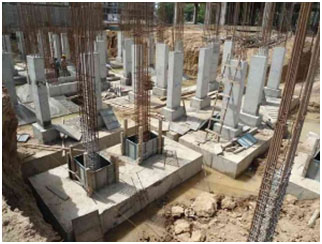
Difference between Footing and Foundation

It is important to know the differences between footing and foundation as these parts are the most important parts in building construction. Understanding the differences between these two important parts helps to understand how the buildings get support from the base.
Concepts about Footing and Foundation
Footing is the piece of concrete that is set into the ground and distributes the weight of the building across the building structure. In contrast, the Foundation is the structure that transfers the weight of the building to the earth.
Footing works as the small type of foundation whereas, a foundation is a large structure that fits on footings or contacts directly with the soil and provides level and even support to the building.

Figure 1: Footing in building construction

Figure 2: Foundation in building construction
Differences on the basis of the appearances
On the basis of appearances, there are numerous differences between foundation and footing.
Location
Footing is located several feet below the ground level and sometimes located below the foundation of the building. Footing is not visible usually. On the other hand, any concrete, that can see under the building, is the foundation part of that building. Some of the footings which are not part of the building’s foundation, might be visible. These parts are located under the sheds, fence posts, or under deck posts.
Size
Those footings that are visible and work as the standalone foundations including shed footings, patio footings, and deck footings are usually less than a foot in diameter. Those footings, which provide support to the buildings are much larger.
On the other hand, foundations are large in size which spans the entire footprint of the building.
Type
Footing can be of four types based on its uses in building construction procedures which include:
Individual Footings:
This type of footing is most common. This kind of footing can appear under smaller structures such as pergola posts or decks. Individual footing contains a single concrete pier that sets into the soil.

Figure 3: Individual Footing
Raft Footings:
This type of footing is the large slabs. This footing is placed directly on the ground’s top and provides support to the building structure above.

Figure 4: Raft Footing
Strip Footings:
Strip footings look like the underground walls. These types of footings help to provide even and continuous support for the building walls which are above the ground.

Figure 5: Strip Footing
Combined Footings:
Two individual footings are placed and adjusted to make combined footings. These two footings are placed one another under the heavy pieces of the building structure.

Figure 6: Combined Footing
On the other hand, the foundation can be categorized into four main types which can include footings. These types are:
Crawl Space Foundation:
This type of foundation consists of concrete block walls and concrete slabs. The concrete slab of this foundation is placed around 4 feet underground and the block walls are around the perimeter. Footings are often included below to give support to the foundation structure.

Figure 7: Crawl Space Foundation
Basement Foundation:
This foundation is similar to the crawl space foundation. However, it is placed much deeper in the ground as compared to a crawl space foundation and sometimes placed on footings. The inside of the basement of this foundation is 7 to 10 feet in height along with poured concrete walls or concrete block walls around the perimeter.

Figure 8: Basement Foundation
Slab Foundation
In this type of foundation, slabs are placed on the ground directly or placed on the deep footings. In this case, there is no under-home area is present. The foundation structure is placed on the top of the slab directly.

Figure 9: Slab Foundation
Pier and Beam Foundation:
concrete piers and wooden beams are the main part of this foundation. The concrete piers are set into the ground and the wooden beams rest on the concrete piers thus providing support to the foundation structure.

Figure 10: Pier and Beam Foundation
Differences on the basis of the Applications
The applications of the footing and foundation are also different from each other.
Construction of houses
In constructing homes, a large and heavy structure is required. In this regard, the foundation system is used in home construction which also involves footings. Usually, it is not seen that a house is sitting solely on footings rather than foundations. In the case of a beam foundation or pier foundation, footing works as a foundation. This kind of use of footing is usually uncommon in residential constructions.
Construction of outbuildings
Some small outbuildings such as detached garages or sheds are lighter than homes. This type of outbuildings sometimes includes footings without a foundation system.
Floating slab foundations are often used for larger sheds and are considered footings as they deliver the structural load to the soil. This floating slab is also considered the foundation as this part can provide the level and even support to the structure above.
To learn more, watch the following video tutorial.
Video Source: Brendan Hasty
Other types of minor construction
In arbors, pergolas, and fence posts, footings are used instead of using complete foundation structures. Individual footings are used in these lightweight structures. These types of individual footings can distribute the load of these structures enough deep in the ground. So, there is no need to be concerned about incidents like soil expansion from moisture or freezing from runoff.


